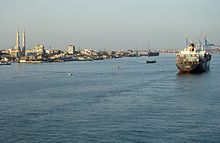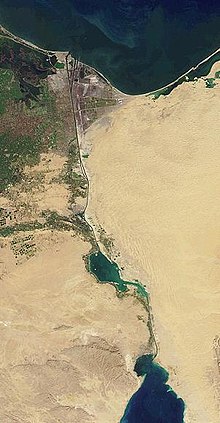Suez Canal
![]()
Suezkanal is a redirect to this article. For the street in Mannheim see Suez Canal (Mannheim), for the canal in the Spreewald see Suez Canal (Spreewald).
30.70532.344166666667
The Suez Canal (in German usually Suezkanal, after the English and French spelling for the port city of Suez; Arabic قناة السويس Qanāt as-Suwais) is a shipping canal in Egypt between the port cities of Port Said and Port Taufiq near Suez, which connects the Mediterranean Sea with the Red Sea via the Isthmus of Suez and spares maritime shipping between the North Atlantic and the Indian Ocean the route around Africa. The canal, which is thus part of the maritime Silk Road, forms the border between Africa and Asia. It was opened on 17 November 1869. Its length at that time was 164 km. Since the deepening completed in 2009, it is 193.3 km long, including the northern and southern approach channels. In 2015, a new section of the canal was opened, running parallel to the existing canal and about 37 km long, straightening the previous stretch and thus shortening it somewhat (for one direction of travel). Around 12% of the world's maritime trade passes through the Suez Canal. In 2015, 17,483 ships passed through the canal for this purpose. In 2019, the last year before the COVID-19 pandemic, there were 18,800 ships. The operator, the Egyptian state-owned Suez Canal Authority (SCA) took in over US$5 billion, an average of more than US$300,000 per transit.
The Suez Canal is a seawater canal. It has no locks and therefore (unlike canals such as the Panama Canal, which have a difference in altitude) does not need a constant supply of water.
The canal can be used by all ships (merchant and warships) of all states in times of peace and in times of war under the same conditions. Certain restrictions apply to warships of belligerent states, for example passage without stopping and no provisioning. This was agreed in the Convention of Constantinople of 29 October 1888, which is still in force. Warships should register their passage with the Egyptian Ministry of Foreign Affairs, the Ministry of Defense and the Maritime Security Authority.
From June 1967 to June 1975, the canal was closed as a result of the Six Day War. In 2003, it was added to the list of historical milestones in engineering by the American Society of Civil Engineers.

sketch map, at least pretty much in order

Entering the Suez Canal at Port Said in May 2008, in the background Port Fouad with its "Great Mosque

Suez Canal (satellite photo), 2001
Largest passage profile for ships
Ships up to Suezmax can navigate the canal. Larger ships fall into the category Capesize (as of 2008) and have to choose a route from southern Asia to Europe via Cape Town, around the southern tip of Africa. (as of 2008)
The Panama Canal is more constricting than the Suez Canal in terms of ship profile. (As of 2008)
The Suez Canal was deepened in 2009/2010; since then, this expansion has enabled ships with a draught of up to 20.1 m to pass through. There is no evidence that water level changes due to tides play a role near the transitions to the seas.
Global melting of ice in the course of climate warming leads us to expect an increasing height of sea levels and thus of the water level in the Suez Canal. Waves and currents generated by shipping traffic tend to cause downward migration, and collisions with a ship's hull cause material on the banks to slide and shift at certain points. Echosounder surveys can investigate changes in channel depth, suction dredging can remove material from the bottom.
Crossings
For the land traffic crossing the canal there are some ferries, a road bridge, a railway bridge (over both arms, see below) and a road tunnel. There are or were concepts for the construction of further tunnels.
Listed from north to south:
- via the "West Arm" (not a functional part of the canal, but part of the Suez Canal Area) in/near Port Said on the Mediterranean Sea
- Port Said Ferry from Port Said to Port F(o)uad City in the southeast of the waterway
- Al Raswa ferry
- El Nasr Floating Bridge (December 2016. 6 pontoons make a total length of 420 m. Usable for cars).
- via the "East Arm" (functionally the Suez Canal)
- Ferry
--
- Qantara Ferryboat Ferry
- Qantara Cars Ferryboat Ferry
- Suez Canal Bridge (Peace, Al Salam, Mubaraj ...) Road bridge with 70 m clear height allows for ships up to 68 m high (opened 2001)
--
Bypass two-arm
--
One-armed
--
Two-armed
--
Water cross connection, still two-armed
--
- unnamed ferry just north of the railway bridge
- El Ferdan railway bridges over the West Arm (2001, single-track swing bridge, out of service since 2014 with the construction of the New Suez Canal (= East Arm)) and New El Ferdan over the East Arm (as of 2017: not yet constructed, decision to build a new double-track bridge and against a tunnel).
--
Water cross connection, still two-branch, at the water T east of the East Branch: New Suez Canal Headquarters
--
- in Ismailia
- via west arm: Nemra 6 Ferry, ferry at road 6 Ismailia
- over Ostarm road bridge
--
Timsahsee communicates west of the West Arm
2 water cross connections between 2 arms
Bitter Lakes
--
In/near the city of Suez:
- Ahmed Hamdi Tunnel of Road 50 (opened in 1981, leaks repaired in 1991, reopened in 1992)
- Ferry The Ferry Road height
Questions and Answers
Q: Where is the Suez Canal located?
A: The Suez Canal is located in Egypt, west of the Sinai Peninsula.
Q: How long is the Suez Canal?
A: The Suez Canal is 163 km (101 miles) long.
Q: What is the width of the Suez Canal at its narrowest point?
A: The Suez Canal is 200 m (656 ft) wide at its narrowest point.
Q: Who built the Suez Canal?
A: The Suez Canal was built by a French company.
Q: When was the construction of the Suez Canal started and completed?
A: The construction of the Suez Canal was started in 1859 and finished in 1869.
Q: What is the purpose of the Suez Canal?
A: The purpose of the Suez Canal is to allow ships to travel between Europe and Asia without having to go the way around Africa, saving time and fuel.
Q: For whom was the Suez Canal built?
A: The Suez Canal was built for Europeans to go to and from the Indian Ocean.
Search within the encyclopedia